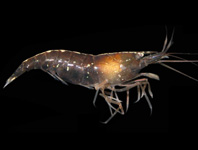Abstract
Benthic siphonophores of the family Rhodaliidae (Cnidaria, Hydrozoa) are extremely fragile, difficult to collect, and therefore little studied. Only a few records exist worldwide, so their ecology remains largely unknown. Rhodaliids have been found at most depth horizons, but until now were believed to mainly inhabit deeper water over continental shelves, with only a few records from ca. 100 m. In this paper, a new rhodaliid is described based on an underwater photograph provided by a recreational diver via Facebook. This observation was made in Milne Bay (Papua New Guinea) at a depth of 26–27 m, and constitutes the shallowest record so far for any rhodaliid. The specimen was tentatively identified as Archangelopsis typica based on observable morphological characters and an approximate estimate of connectivity between all rhodaliid species in the Indo-Pacific region. Additionally, we highlight the scientific potential of citizen science.
References
Araujo, E.M. (2012) Sistemática y distributión de los sifonóforos (Cnidaria/Hydrozoa) del Océano Atlántico Sudoccidental. Universidad Nacional de Mar del Plata (Argentina), Facultad de Ciencias Exactas y Naturales, Mar del Plata, 210 pp. [in Spanish, PhD Thesis]
Bigelow, H.B. (1913) Medusae and Siphonophorae collected by the U. S. Fisheries steamer “Albatross” in the northwestern Pacific, 1906. Proceedings of the United States National Museum, 44 (1946), 1–119.
https://doi.org/10.5479/si.00963801.44-1946.1Carré, D. (1969) Étude histologique du développement de Nanomia bijuga (Chiaje, 1841), siphonophore physonecte, Agalmidae. Cahiers de Biologie Marine, 10, 324–341.
Gallagher, S.T., Kitamura, A., Iryu, A., Itaki, T., Koizumi, I. & Hoiles, P.W. (2015) The Pliocene to recent history of the Kuroshio and Tsushima Currents: a multi-proxy approach. Progress in Earth and Planetary Science, 2 (17), 1–23.
https://doi.org/10.1186/s40645-015-0045-6Ganachaud, A., Cravatte, S., Melet, A., Schiller, A., Holbrook, N.J., Sloyan, B.M., Widlansky, M.J., Bowen, M., Verron, J., Wiles, P., Ridgway, K., Sutton, P., Sprintall, J., Steinberg, C., Brassington, G., Cai, W., Davis, R., Gasparin, F., Gourdeau, L., Hasegawa, T., Kessler, W., Maes, C., Takahashi, K., Richards, K.J. & Send, U. (2014) The Southwest Pacific Ocean circulation and climate experiment (SPICE). Journal of Geophysical Research: Oceans, 119 (11), 1–27.
https://doi.org/10.1002/2013JC009678Gibbons, M.J., Buecher, E., Thibault-Botha, D. & Helm, R.R. (2010) Patterns in marine hydrozoan richness and biogeography around southern Africa: implications of life cycle strategy. Journal of Biogeography, 37, 606–616.
https://doi.org/10.1111/j.1365-2699.2009.02237.xHissmann, K. (2005) In situ observations on benthic siphonophores (Physonectae: Rhodaliidae) and descriptions of three new species from Indonesia and South Africa. Systematics and Biodiversity, 2 (3), 223–249.
https://doi.org/10.1017/S1477200004001513Hissmann, K., Schauer, J. & Pugh, P.R. (1995) Archangelopsis jagoa, a new species of benthic siphonophore (Physonectae, Rhodaliidae) collected by submersible in the Red Sea. Oceanologica Acta, 18 (6), 671–680.
Lens, A.D. & van Riemsdijk, T. (1908) The Siphonophora of the “Siboga” Expedition. Siboga Expeditie, 9, 1–130.
Mapstone, G.M., Corbari, L. & Menot, L.M. (2016) Two deep-living rhodaliids (Cnidaria, Siphonophora) from the Mid-Atlantic Ridge. Marine Biology Research, 13 (5), 486–493.
https://doi.org/10.1080/17451000.2016.1232830Mapstone, G.M. & Ljubenkov, J.C. (2013) New observations on Dromalia alexandri Bigelow, 1911, a rhodaliid physonect siphonophore from Southern Californian waters. Marine Ecology, 34 (Supplement 1), 96–112.
https://doi.org/10.1111/maec.12029Pugh, P.R. (1983) Benthic siphonophores: a review of the family Rhodaliidae (Siphonophora, Physonectae). Philosophical Transactions of the Royal Society B, 301 (1105), 165–300.
https://doi.org/10.1098/rstb.1983.0025Qiu, B. (2001) Kuroshio and Oyashio currents. In: Steele, J.H. (Ed.), Encyclopedia of Ocean Sciences. Academic Press, New York, pp. 1413–1425.
https://doi.org/10.1006/rwos.2001.0350Silvertown, J. (2009) A new dawn for citizen science. Trends in Ecology and Evolution, 24 (9), 467–471.
https://doi.org/10.1016/j.tree.2009.03.017Wolanski, E., Lambrechts, J., Thomas, C. & Deleersnijder, E. (2013) The net water circulation through Torres strait. Continental Shelf Research, 64, 55–74.
https://doi.org/10.1016/j.csr.2013.05.013ID Please (Marine Creature Identification) (2017) Available from: https://www.facebook.com/groups/idpls/?fref=ts (accessed 17 January 2017)
JellyWatch Home (2017) Available from: www.jellywatch.org (accessed 3 March 2017)

